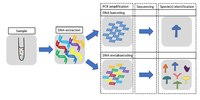
Photo from wikipedia
Metabarcoding of environmental DNA is increasingly used for biodiversity assessments in aquatic communities. The efficiency and outcome of these efforts are dependent upon either de novo primer design or selecting… Click to show full abstract
Metabarcoding of environmental DNA is increasingly used for biodiversity assessments in aquatic communities. The efficiency and outcome of these efforts are dependent upon either de novo primer design or selecting an appropriate primer set from the dozens that have already been published. Unfortunately, there is a lack of studies that have directly compared the efficacy of different metabarcoding primers in marine and estuarine systems. Here we evaluate five commonly used primer sets designed to amplify rRNA barcoding genes in fishes and compare their performance using water samples collected from estuarine sites in the highly biodiverse Indian River Lagoon in Florida. Three of the five primer sets amplify a portion of the mitochondrial 12S gene (MiFish_12S, 171bp; Riaz_12S, 106 bp; Valentini_12S, 63 bp), one amplifies 219 bp of the mitochondrial 16S gene (Berry_16S), and the other amplifies 271 bp of the nuclear 18S gene (MacDonald_18S). The vast majority of the metabarcoding reads (> 99%) generated using the 18S primer set assigned to non-target (non-fish) taxa and therefore this primer set was omitted from most analyses. Using a conservative 99% similarity threshold for species level assignments, we detected a comparable number of species (55 and 49, respectively) and similarly high Shannon’s diversity values for the Riaz_12S and Berry_16S primer sets. Meanwhile, just 34 and 32 species were detected using the MiFish_12S and Valentini_12S primer sets, respectively. We were able to amplify both bony and cartilaginous fishes using the four primer sets with the vast majority of reads (>99%) assigned to the former. We detected the greatest number of elasmobranchs (six species) with the Riaz_12S primer set suggesting that it may be a suitable candidate set for the detection of sharks and rays. Of the total 76 fish species that were identified across all datasets, the combined three 12S primer sets detected 85.5% (65 species) while the combination of the Riaz_12S and Berry_16S primers detected 93.4% (71 species). These results highlight the importance of employing multiple primer sets as well as using primers that target different genomic regions. Moreover, our results suggest that the widely adopted MiFish_12S primers may not be the best choice, rather we found that the Riaz_12S primer set was the most effective for eDNA-based fish surveys in our system.
Journal Title: PLoS ONE
Year Published: 2022
Link to full text (if available)
Share on Social Media: Sign Up to like & get
recommendations!